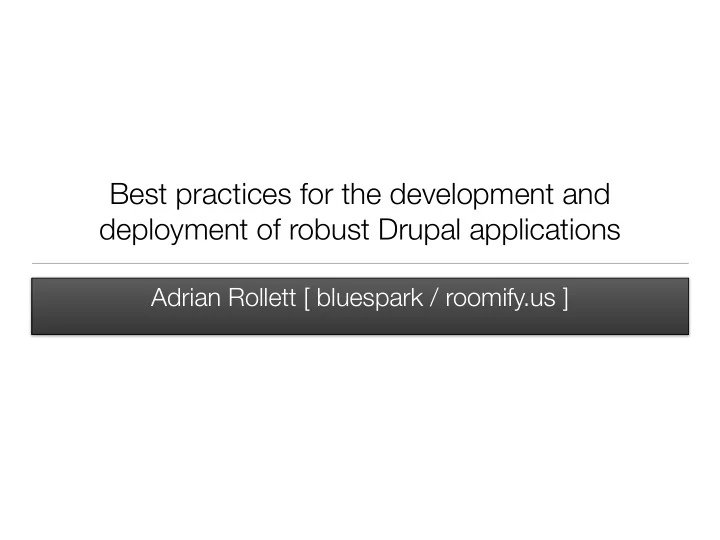

Best practices for the development and deployment of robust Drupal applications Adrian Rollett [ bluespark / roomify.us ]
Technical Director / Bluespark full-service web agency long record of contribution design . ux . development
Co-founder / roomify.us DRUPAL product spin-o ff from bluespark flexible booking solutions ROOMS drupal-based . open-source FLEXIBLE, POWERFUL ONLINE BOOKING
Goals • build (and build upon!) robust Drupal applications • learn useful processes / philosophies • discuss implementation strategies Dean Hochman . Flickr Dean Hochman . Flickr
What makes an application a good application?
“any program is only as good as it is useful.” –Linus Torvalds
• does what it’s asked • performs well • stable and reliable • functional and attractive on *all* devices
Ken Hodge . flickr Preparation
What is your process?
proc · ess noun a series of actions or steps taken in order to achieve a particular end.
What are the elements of your process? methodology . patterns . best practices
the Order of Things • user experience design • visual design • technical design
Will Scullin . flickr Technical Design • best done with multiple people: we involve members of the UX, design and technical teams • time-consuming but worthwhile • plan and estimate • finished production: complete implementation timeline + tickets
Working within Budget • If the client is completely bought into an agile process, budget per sprint and iterate • If project is fixed budget, up front planning and communication of scope is completely essential (from apelbaum.wordpress.com) [1]
Sascha Kohlmann . flickr The Build-out
There is no substitute for proper technical planning
Managing time during Development • Agile • Kan-ban • Waterfall
How we do it • Agile sprints with explicit QA/Code review steps for individual tickets • Managed within the overall scope/timeline framework defined during the Technical design and estimation process
Parallel development / External teams • Plan first, then execute • Dependency order is vitally important to figure out up front • Specify, specify, specify
QA
“QA is culture, not a step.”
Where does QA happen? • Up front, during technical design • During development - code standards matter! • Code review • Automated code testing • Formal QA
Testing • The two most important things you can know about testing: • Do it! • Automate it - tests that don’t get run automatically don’t do their job • For more than you wanted to know, see our presentation: Quantifying the Value of Devops [3] gozalewis . flickr
Just Add Light . flickr On-going development - balancing concerns
Define the goals • new features • bug fixes • continued stability
How do we meet them?
“Undeployed Code Is Inventory; Inventory Is Risk.” –xaprb.com [2]
The more you deploy, the easier it gets kevin utting . flickr
but don’t deployments take lots of time?
Automate, automate, automate • Work towards a model where each functional pice of code is tested individually and automatically in its own environment • Make sure the results are seen by humans - we run tests via jenkins and send the output to our company chat • This environment should be identical to the production environment in all aspects possible • You can build it, or you can buy it
Testing
• Any test is better than none, IF it runs automatically • Don’t let perfect be the enemy of good, it’s OK not to have 100% test coverage • Identify what must work, and test that functionality • ecommerce: cart/checkout • brochure site: home page, contact form • intranet: user login, permissions • and so on
Extra Credit: Continuous Deployment • Ensure all deployment steps exist in code that is itself reviewed and tested • Don’t deploy new code without new tests • All tests must pass to deploy • Rollback must also be automated
Conclusions • Define your process and make your workflows fit it • Plan *before* you build • Automate all the things • Test the important things • Deploy as frequently as possible seattle municipal archives . flickr
Questions?
Thank you! adrian@roomify.us twitter.com/acrollet
Resources • [1] Choosing Between Schedule, Budget, Scope, and Quality • [2] Code Freezes don’t prevent outages • [3] Quantifying the business value of devops
Recommend
More recommend